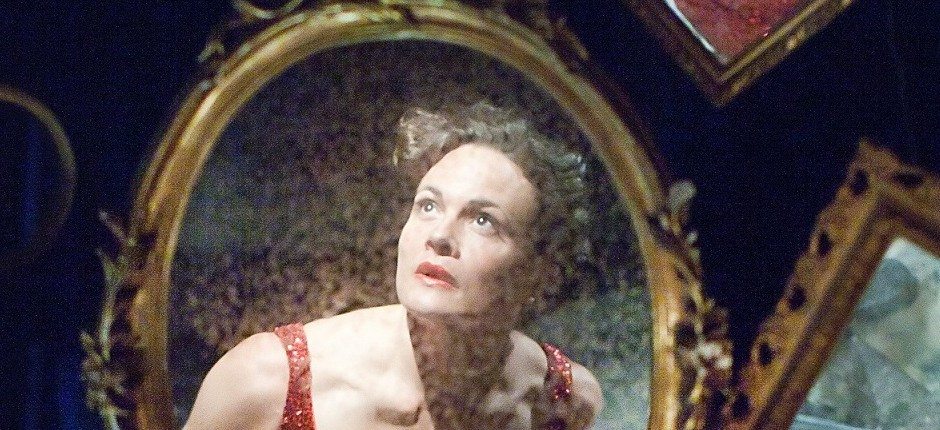Punchdrunk’s Hollywood Fable
The Drowned Man: A Hollywood Fable
Have you ever seen nature inside out? When the sun stands at midday and it’s as if the world was going up in flames?
Having lost my companions, midway through The Drowned Man, I found myself completely alone at the top of a stairwell, stood at the threshold of a doorway framed by mysterious, red light.
I had anticipated that upon first being ‘Punchdrunked’ I would be frantically attempting to follow the plot of the company’s nuanced re-working of Bruchner’s Woyzeck. If not, perhaps I would be immersed in unwinding the Lynchian motifs around the grounds of ‘Temple Studios’; the surrealist realm of blurred verisimilitude and fantasy in which we found ourselves. Maybe even I would be discovering intricately arranged details and Easter Eggs, like the three-page letter from one glamorous Hollywood lover to another I had found earlier in a room full of dunes. I had become lost in reading this letter, until I looked up and found myself surrounded by fellow, masked ‘active spectators’ keenly anticipating the discovery of a narrative clue.
Yet at this juncture, hand reaching out for the handle, sand on the concrete beneath my feet, and cold sweat on my brow despite the heat, all of the conventional expectations I might have held of experiencing this production could not have been further from my mind. All I held instead was total, exhilarating fear.
Punchdrunk have been pioneering their style of promenade-and-then-some experiences for thirteen years and this latest production sets them on their grandest scale yet. It is assembled in 200,000sq. feet of cavernous sorting office next to Paddington station, a solitary Royal Mail sign being the only visible clue I encountered of its former bearing. The two sets of a 34-strong cast performed their shared narrative of paranoia, betrayal and violence three times over, with the genders of the leads flipped and the settings drastically different on the various floors, but somehow all immaculately unfolding simultaneously.
Within such enormity, it is only appropriate that dialogue was at a premium. Aside from the odd flirtatious greeting, burst of jealous outrage, or the ominous director’s voice dictating the screenplay over the speakers, this world of darkness moved too quickly for words, with the participants, masked or otherwise, disappearing in the blink of an eye. Consequently, those who look for direct clarity or insight will be disappointed. For even when dedicating my final hour almost exclusively to following the characters of Wendy (Sophie Burtolussi) and Marshall (Fionn Cox-Davies) through caravans, dance-halls and doctors’ offices, it led only to further, overwhelming silence, broken only by the sparse moments of speech which became all the more unsettling and disorientating.
Perhaps even more alienating was that such an attempt to unearth the plot inevitably felt almost a waste of the experience. My decided journey quite satisfyingly rendered at least one group’s version of events, but it ultimately led to a sense of loss elsewhere and raised more questions than answers in terms of motivation, subtext and meaning. A recurring theme of the evening was the physical and psychological process of becoming fixated upon a room or character. The audience were forced to let go of such a propensity and to move on elsewhere, then face the regret at the possibility of having missed something left behind. In Temple Studios, frustration can be just as common as unqualified, intangible, sensory joy.
This abstraction of ‘action’ combined with the loading of so many dozens of spaces with intriguing but superficial details might provide a source of criticism for The Drowned Man as an experience. Some audience members might have been left cold by the peculiarly Hollywood bareness paired with grandiosity. It is in this very grey space though, that the rawest, purest and most significant elements of the kaleidoscope conjured by directors Felix Barrett and Maxine Doyle came into view.
The primal and carnal were foregrounded in performance and production, allowing emotions like my isolated and profound fear of a door to surface. In place of the vocal, the dominant mode of expression for the actors lay within organically wild movement and the visceral, alien dynamism of their dancing. Just as integral to the production was the gorgeously eerie soundtrack that emanated from speakers in every corner, providing the cues of momentum and driving the mood of the evening, as it rumbled among the pine forests, deserts and trailer-parks.
Within this transformed and transforming space, was the intoxicating combination of spectacular vistas and intimate moments of human frailty, which dominated the senses, first throughout the three-hour run-time and then continuing in the imagination for days after. Punchdrunk challenge notions of purpose and mechanisms in theatre and in turn potentially reveal truths of human nature. Recommending The Drowned Man doesn’t quite feel enough. No matter which experiential pole you land upon, it will leave you gasping for air.
The Drowned Man: A Hollywood Fable is presented by Punchdrunk and the National Theatre and will be performed at Temple Studios, London until 31st December 2013.

Comments